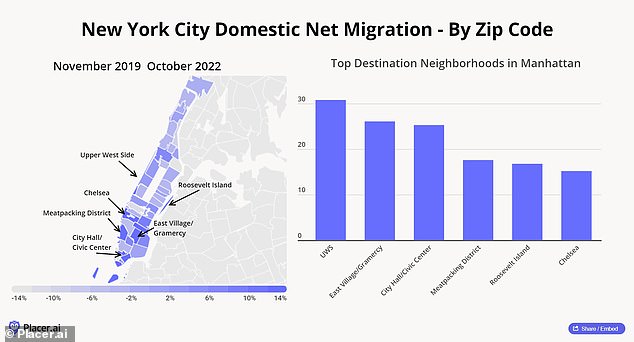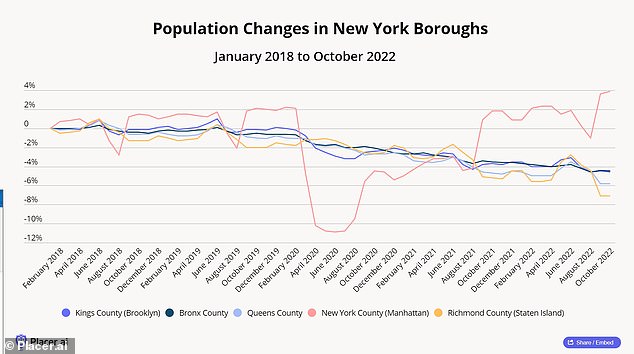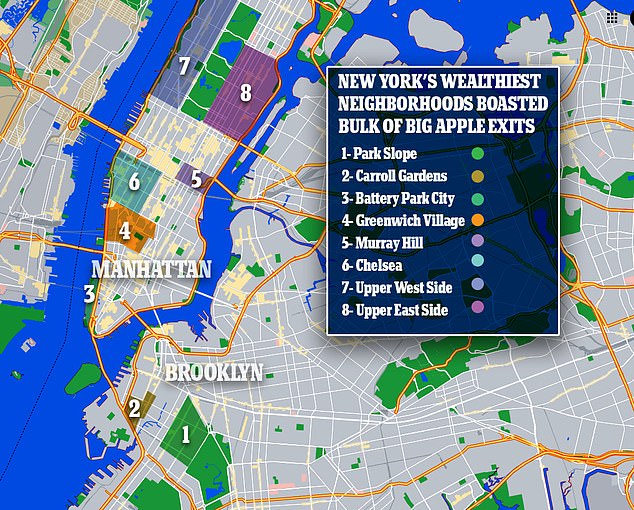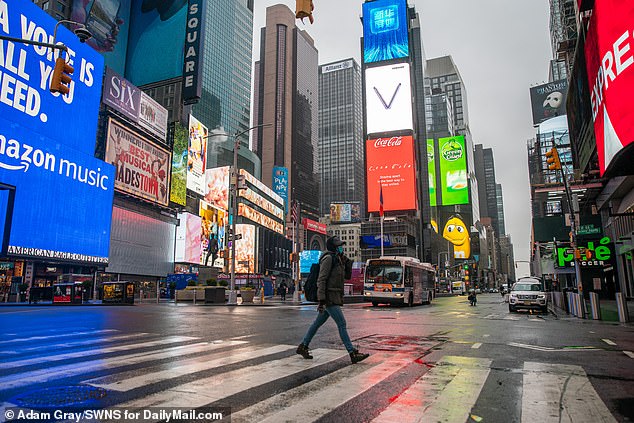Manhattan now has MORE residents than it did pre-pandemic and with median rent up to $4,200 a month
>
New Yorkers are seeing a post-pandemic population boom after seeing their streets empty in 2020 and 2021, a new study has revealed.
The report, by post-pandemic tracker Placer.ai, shows that Manhattan, the borough hardest hit by the mass exodus from the Big Apple, is well on its way to recovery.
Meanwhile, other less-affected boroughs, like Brooklyn and the Bronx, are in surprising decline.
The phenomenon, which comes hand in hand with the sharp drop in the city’s population during the first days of COVID-19, is already increasing rents, in a city that year after year already earns the dubious distinction of being the place least affordable to live. the country.
Once serving as the epicenter of the debilitating virus, the city, at least its wealthier parts, has returned to its former state, data shows.

New York neighborhoods are experiencing a post-pandemic population boom after their streets emptied in 2020 and 2021, a new study has revealed.
The study authors credited the astonishing recovery, showing a population increase of almost 4 percent from more than two years before the pandemic to last November. to the famous resilience of New Yorkers in times of crisis.
As for the stagnation seen in outer boroughs, Placer staff, which monitors various consumer-related metrics across the United States, blamed the lack of office and retail stores that is notably prevalent in the big city.
“The recovery of retail and office space in New York City is an affirmation of the unique environment that can only be found there,” said Ethan Chernofsky, vice president of marketing for Placer.ai.
“While there are areas that have been hit harder, it’s hard to imagine a scenario where they don’t see an equally powerful recovery over time.”
Particular neighborhoods will see an uptick from January 2018 to last fall, as lockdown restrictions and both masks and vaccine mandates were relaxed, including on the Upper West Side and several areas of Lower Manhattan.
Downtown neighborhoods, which included the East Village, the Meatpacking District and Chelsea, were all located in office-rich areas, signaling the slow return of some businesses to in-person work.

The report, by post-pandemic tracker Placer.ai, shows that Manhattan, the borough hardest hit by the mass exodus from the Big Apple, is well on its way to recovery. Meanwhile, other boroughs like Brooklyn and the Bronx are in surprising decline.
The Upper West Side led the increase in residents, the report showed, registering an influx of 30 percent of residents between November 2019 and last October 2022.
A neighborhood famous for its wealth located on the Hudson River, change of address information provided by the United States Postal Service showed that its residents they were 4.6 times more likely to flee than other citizens during the first year of the pandemic.
According to Placer’s report, the citizens of the neighborhood – which is practically all residential and is home to tens of thousands of upper-middle-class families – Now they’re back in full force
Next up were residents of the equally wealthy East Village and Gramercy areas, as well as the immediate area around the city courts and City Hall, who hovered around 25 percent during that same period.
Villages in those neighborhoods were just as likely to move out of their posh downtown digs as their affluent uptown counterparts, recording 109 net moves per 1,000 residents, according to data from the city comptroller’s office.
The study authors attributed this uptick to the area’s “active nightlife, extensive dining options, and strong cultural institutions,” which, they wrote, “may be attracting people looking to boost their social life” after two years of social distancing.
Others, they said, are likely “seeking more opportunities to get out of the house and spend time with friends,” citing how downtown areas serve as notable hubs for the city’s signature nightlife.

In less affluent areas of the borough, such as Harlem and the Bronx, where just 24 in 1,000 moved elsewhere in 2020 compared to 109 net moves in more affluent neighborhoods, populations are only just beginning to approach pre-Columbian levels. pandemic.
That said, areas known for their trendy restaurants and nightclubs, like Chelsea and the Meatpacking District, also saw steep increases in population beyond what they had seen before the coronavirus. Both areas were also among the neighborhoods that saw the largest numbers of residents leave for places like Miami or upstate during the early days of the outbreak.
And as the mass exodus of affluent citizens caused by the pandemic sent rental prices plummeting, their mass return sent rents soaring again, much higher than they had been before the pandemic.
In November, Manhattan’s median rent hit a record $4,200, up 24 percent from 2021, even as sales prices have cooled slightly in the past two quarters amid recent Federal Reserve rate hikes and uncertainty about the current state of the economy.
Once serving as the epicenter of the debilitating virus, the city, at least its wealthier parts, has now, at least in terms of population, returned to its former state.
In the less affluent areas of the borough, such as Harlem and the Bronx, where just 24 in 1,000 moved elsewhere in 2020 compared to 109 net moves in more affluent neighborhoods, populations are beginning to approach pre-June levels. the pandemic.
Yet in places like Brooklyn, the Bronx, Queens, and Staten Island, where offices are scarce and citizens earn far less to live on, populations have yet to recover and have actually declined from pre-cash levels. pandemic.
From January 2018 to October 2022, the population decreased by 4.5% in The Bronx, 4.6% in Brooklyn, 5.8% in Queens, and 7.1% on Staten Island.
Meanwhile, Brooklyn’s hippest spots, like the downtown neighborhood and Williamsburg, have seen their populations surpass pre-2020 levels, growing around 5 percent and 3 percent, respectively, according to the report.

During the spring of 2020, when New York was the epicenter of the COVID-19 pandemic in the US, residents of the wealthiest neighborhoods were 7.2 times more likely to move elsewhere Pictured: a Empty Times Square on March 23, 2020
Coney Island, a rapidly gentrifying neighborhood becoming increasingly popular with families, is up 6 percent over that nearly three-year period.
Other neighborhoods popular with transplants moving to New York, such as Prospect Heights, Bed-Stuy and Greenpoint, all within easy reach of Manhattan, were also among the neighbors that saw increases, growing at a rate of about 2 percent. .
The results come after the population of the municipality fell by 8.1% from February to April 2020, and the vast majority of those who moved from areas where the median income exceeds $110,000 per year.
Officials at the time estimated that a record 131,000 New York residents left the city between the months of March 2020 and June 2021 alone, triple the rate in previous months. That data was recorded when the city was declared the epicenter of the national outbreak in April.
